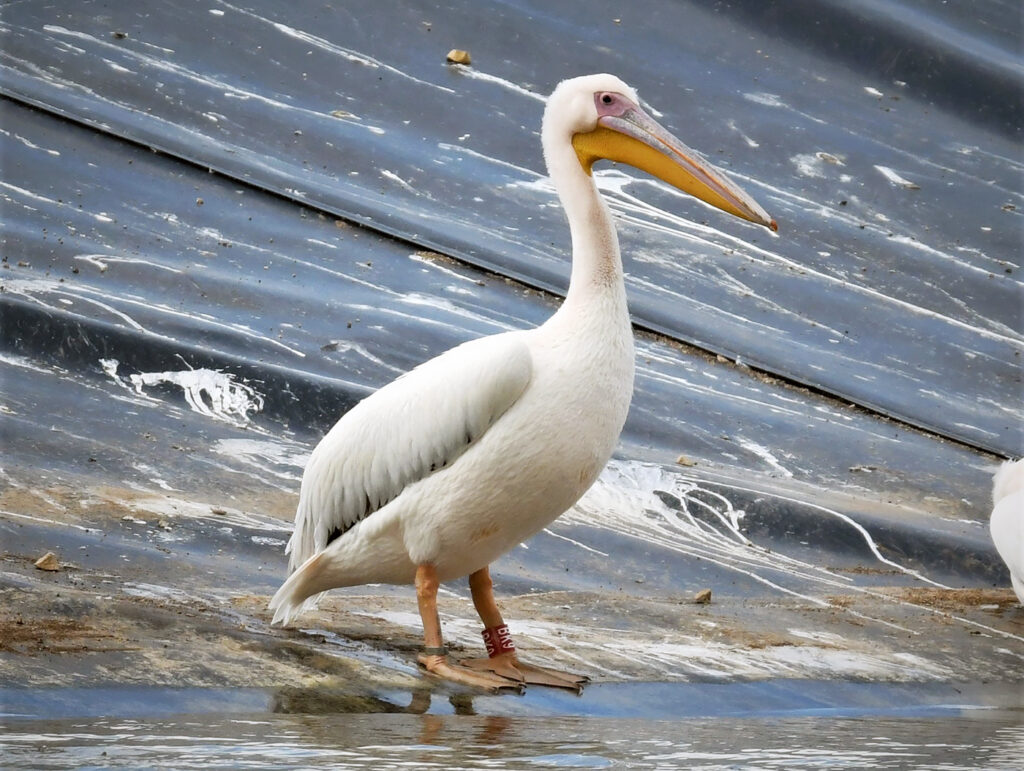It’s been two years since the Bulgarian Society for the Protection of Birds began monitoring the travels and escapades of Vaya, the Great White pelican.

Vaya was captured and fitted with a satellite transmitter in the Burgas Lake area back in September 2021. Notably, this marked the first time a Great White pelican in Bulgaria was equipped with such a transmitter.
In contrast to Dalmatian pelicans, Great White pelicans are renowned for their more extensive migrations. Each year, Bulgaria witnesses the passage of tens of thousands of Great White pelicans during their migration, representing the entire European population of this captivating species.
“Thanks to Vaya, we’ve acquired extremely valuable and intriguing data about the ecology of Great White pelicans over these past two years. Some of this information is entirely novel, even for scientists dedicated to the study of this species. Throughout this period, Vaya has covered a remarkable 13,364 kilometers, making visits to 12 countries: Bulgaria, Romania, Ukraine, Greece, Turkey, Syria, Lebanon, Israel, Jordan, Egypt, Sudan, and South Sudan,” says Svilen Cheshmedjiev, an ornithologist from BSPB.

During the previous winter, Vaya chose to forego the typical migration to Africa and instead spent the winter months in Israel. Her presence was frequently documented by local ornithologists. Fortunately, she managed to steer clear of the bird flu outbreak that had plagued the region at that time.
On April 17, 2022, Vaya initiated her northward migration. After a brief two-day stopover in Syria, she spent approximately a week at various lakes in Central and Northwestern Turkey. By May 4, she had made her way to the deltas of the Maritsa River in Greece, and the very next day, she arrived at Mandrensko Lake near the city of Burgas. During the spring and summer, the pelican resided in her preferred area, the Danube Delta, with occasional visits to Lake Srebarna, Lake Kaliakra, and the sandy shores along the Danube River.

In early September, Vaya returned to the Burgas Lakes to stock up on food, and by mid-September, she was on her way south. This time, she opted to spend the winter in Africa. She successfully crossed the Suez Canal, tracing the course of the Nile River and pausing for a few days at the Toshka Lakes in the Sahara Desert in Egypt. Over the ensuing weeks, Vaya continued to follow the Nile River’s path and reached the territories of South Sudan, where she remained throughout the winter.
In April 2023, the bird began her northward migration again, and after several weeks of stopovers in Egypt, Israel, and Turkey, on June 7, Vaya returned to Bulgaria and was observed to spend the night on the dykes of Atanasovsko Lake. After a few days of well-deserved rest, the pelican resumed her journey northward and found herself at Lake Srebarna. Throughout the summer, Vaya explored Lake Kaliakra in Romania and various wetlands in the Danube Delta. More recently, the pelican was spotted in the marshes of Small Tataru Island, situated near the city of Izmail in Ukraine. Her most impressive single-day journey covered a distance of 309 kilometers, and the highest altitude she reached during the flight was recorded at a remarkable 2,297 meters above sea level.
“At any moment, we anticipate Vaya’s resumption of her southward migration, and we wish her a safe and trouble-free journey to her wintering grounds. She’s likely to make a brief stopover in the Burgas Lakes, where our team will be eagerly awaiting her,” adds Svilen.
The tagging of Great White pelicans with transmitters is a groundbreaking initiative in Bulgaria and marks a significant advancement in the study of this species. Recently, the BSPB team tagged a second Great White pelican. Through data collected from leg rings and satellite telemetry, scientists can monitor the birds’ movements, pinpointing areas where pelicans feed, rest, migrate, winter, and nest. Additionally, these transmitters provide valuable real-time data on their speed, altitude, and flight patterns. Thanks to this technology, scientists will gain a deeper understanding of the ecology, movements, and threats facing the species, facilitating the planning and execution of future conservation measures.
The activities related to the conservation of Dalmatian and Great white pelicans are carried out within the framework of the “Pelican Way of LIFE“ initiative (LIFE18/NAT/NL/000716), funded by the LIFE Programme of the European Union and Arcadia Foundation, and with the assistance in Bulgaria of the Whitley Fund for Nature.
